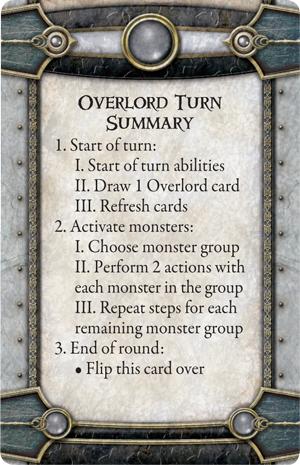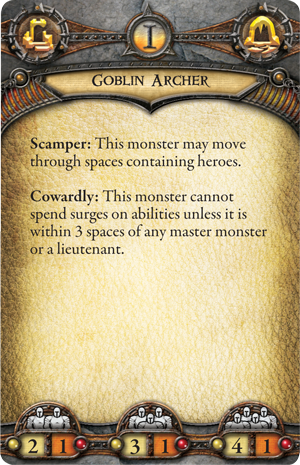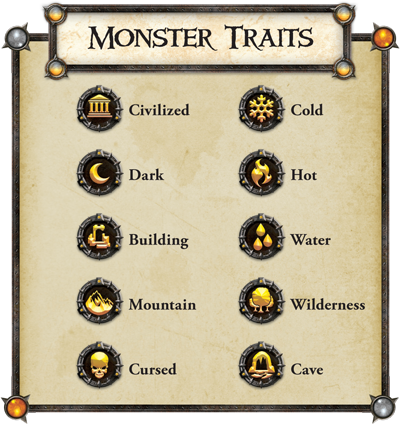No puedo negar mi interés por la re-edicion de este juego, al que voy a seguir hasta que los chicos de Edge decidan traerlo traducido al castellano, cosa que estoy seguro que ocurrirá.
Hoy FFG nos ofrece suculenta información sobre los cambios en determinadas mecánicas y lo más importante los monstruos, sus claves y funciones.
As the release of Descent: Journeys in the Dark Second Edition approaches, we venture ever onward in our series of previews. Two weeks ago, we heard from designer Adam Sadler regarding his favorite aspects of Second Edition. Last week, we saw an overview of Jain Fairwood’s Hero sheet, and we learned about the choices that hero players can make on their turns.
 Today,
we’ll explore the other side of the struggle for Terrinoth’s fate: the
nefarious overlord and his army of foul minions. We’ll learn how Second Edition’s
elegant approach to Overlord cards further emphasizes the game’s focus
on accessibility, while still maintaining a strong sense of strategy.
We’ll also look at monsters, how they arrive on a map, and some of the
choices a clever overlord can make to effectively use them.
Today,
we’ll explore the other side of the struggle for Terrinoth’s fate: the
nefarious overlord and his army of foul minions. We’ll learn how Second Edition’s
elegant approach to Overlord cards further emphasizes the game’s focus
on accessibility, while still maintaining a strong sense of strategy.
We’ll also look at monsters, how they arrive on a map, and some of the
choices a clever overlord can make to effectively use them.Watching from the Shadows
Last week, we previewed the hero side of the Activation card, which lists a hero’s turn summary and his choice of actions. After a hero player has finished his turn, he flips this card to its overlord side (shown at the right) until the start of the following round. Once all the heroes have had their turns, it’s the overlord’s chance to destroy those meddling fools!
The overlord player begins by resolving any “Start of turn” abilities, then he draws one card from his Overlord deck (if his deck has run out, he simply shuffles the discard pile before drawing; first edition’s Conquest Points are a thing of the past). After refreshing cards that he exhausted on his previous turn, the overlord activates each of his monster groups in any order he chooses, then flips his card to indicate the end of his turn. While this turn sequence may sound simple (especially compared to the range of actions listed on the hero turn summary), the overlord’s role is more compelling than ever before, due largely to the Overlord cards themselves.

Dash, Word of Misery, and Critical Blow are just
three of the overlord’s nasty tricks.
Overlord cards in Second Edition
are played according to their individual triggering conditions (first
edition’s threat tokens have likewise been left out), which can arise at
any point in the round...even on the heroes’ turns. A ruthless
adversary, the overlord can strike at any time and without notice, so
when this player is flush with cards and sporting a sinister grin,
heroes would do well to tread carefully. What’s more, Second Edition
features some light deck-building elements for the overlord player! The
cards shown above each have the word “basic” in the lower left corner,
and a number 0 in the lower right. That is because these cards are each
part of the overlord’s “basic” starting deck of fifteen events, traps,
and magic spells (you won’t find spawn cards, since monsters enter play
differently than in first edition; more on that below). The number in
the lower right is used in the campaign rules, and indicates the amount
of experience points the overlord must spend to add that card to his
deck.
What’s more, Second Edition
features some light deck-building elements for the overlord player! The
cards shown above each have the word “basic” in the lower left corner,
and a number 0 in the lower right. That is because these cards are each
part of the overlord’s “basic” starting deck of fifteen events, traps,
and magic spells (you won’t find spawn cards, since monsters enter play
differently than in first edition; more on that below). The number in
the lower right is used in the campaign rules, and indicates the amount
of experience points the overlord must spend to add that card to his
deck.For example, an overlord with a penchant for throwing wrenches in the heroes’ plans might pursue the “Saboteur” class, adding a card like Wicked Laughter to his arsenal. Or, he might prefer a more balanced approach, purchasing a class-neutral card like Plan Ahead. Whatever he decides, the overlord may begin each quest by paring down to a fifteen card deck (its minimum permitted size), thereby increasing the likelihood he’ll draw his favorite cards. This means that over the course of a campaign, the overlord can customize his deck to fit his unique style of dispatching hapless do-gooders.
An Army of Minions
Even when armed with the best deck, an overlord needs servants to carry out his evil bidding. Another rich source of strategic choices for the overlord player, monsters keep the pressure on as heroes struggle to complete a scenario’s objective.


The front and back sides of an Act I Monster card. Click to enlarge.
Take a look at the goblin archer card above. Each Monster card in Second Edition is efficiently packed with information, nearly eliminating the need to check the rulebook for pertinent details. The Act Icon is used in campaign play, indicating that (in this case) the monster is appropriate for Act I of the story (monsters get more difficult to defeat in Act II,
after the interlude). Aside from that, it’s important to notice that a
Monster card is essentially divided into two sets of statistics. The
characteristics, abilities, and dice found above the portrait pertain to minion monsters (represented by white plastic), while that information found below the portrait pertains to master monsters (represented by red plastic).Turning to the back of this Monster card, we first see convenient definitions of any abilities listed on the front side (we’ll explain surge icons in a future preview). Above those are the monster’s traits, and along the bottom are monster group limitations, which are used when scaling Second Edition to accommodate different numbers of heroes.
Incoming Reinforcements

But what is a monster group, and what do those trait icons do? “Monster group” is a term applied to all monsters of a single type, and this concept represents another major difference between Second Edition and its predecessor. Any given monster on the board is said to be part of a monster group, even if it’s alone in a group of one. For example, all minion goblin archers and master goblin archers are, for mechanical purposes, collectively referred to as the “goblin archer monster group.”
That’s important because each encounter’s instructions (and many card effects) refer to monsters based on groups, using this measurement to indicate when and where the overlord’s vile minions enter play, among other things. This brings us to the way monsters enter play (known as “spawning” in first edition), which in Second Edition is tightly controlled by the rules of each particular encounter.
Early in development, the decision was made to move away from first edition’s emphasis on line of sight as a determining factor in adding new monsters to the board. While tactically interesting, first edition’s spawning rules sometimes resulted in unthematic situations in which heroes would deliberately “cover the angles,” preventing the entry of new monsters. Alternatively, the overlord would often work to flood the board with monsters, stopping up important choke points and overwhelming heroes. Second Edition has seamlessly addressed both of these concerns, placing the emphasis back on narrative and engaging play.

An excerpt from an encounter that calls for one group of goblin archers (respecting group limits
based on the number of heroes), plus one monster group of the overlord’s choosing. The overlord
may choose any monster with a trait that matches one of the icons in the upper right. Click to enlarge.
Monsters
therefore begin in play according to an encounter’s setup instructions,
and predetermined reinforcements arrive at a steady, controlled pace
(if at all), likewise according to the instructions. Direct your
attention to the Quest Guide excerpt pictured above. The first
part of a quest entitled “A Fat Goblin,” this encounter instructs the
overlord to set the board up with one group of goblin archers and one
“open group.”
This means that the overlord has a choice of which monsters he uses to challenge the heroes, as long as his chosen monster group bears at least one of the encounter’s permitted traits (the icons in the upper right corner of an encounter’s instructions).
In addition to the encounter’s required goblin archers, the overlord has a range of options for that open group. He can pick any type that has either the “Wilderness” or the “Civilized” trait on its Monster card, including such choices as flesh moulders and barghests from the base game, or beastmen and sorcerers if he has first edition’s plastic and the Conversion Kit’s cards.
We’ve presented plenty of new information today, but there’s a great deal more to learn. Keep checking back for more in the coming weeks, and look for Descent: Journeys in the Dark Second Edition and the Conversion Kit this summer!




















0 comentarios :
Dí lo que piensas...